 | |
Armenia | Mexico |
|---|---|
Diplomatic relations exist between Armenia and Mexico. Both nations are members of the United Nations.
 | |
Armenia | Mexico |
|---|---|
Diplomatic relations exist between Armenia and Mexico. Both nations are members of the United Nations.


A month after the dissolution of the Soviet Union in December 1991; Armenia and Mexico established formal diplomatic relations with each other on 14 January 1992. [1] Since the beginning, relations between both nations have been kept on a rather low level and held mainly when relating to diplomatic issues on a global level at the United Nations. In March 2002, Armenian Prime Minister Andranik Margaryan came to the northern Mexican city of Monterrey to attend the Monterrey Consensus Conference; this visit becoming the first and highest level Armenian government official to visit Mexico since independence. In August 2002, Armenian foreign minister Vartan Oskanian paid an official visit to Mexico. During his visit, both nations signed agreements on cooperation in the fields of culture and education as well as an agreement to abolish visas for official and diplomatic passport holders. [1]
In October 2012, Armenian foreign minister Eduard Nalbandyan paid and official visit to Mexico. During his visit, foreign minister Nalbandyan expressed his concerns over Mexico's recognition in 2011 of the Khojaly Massacre where approximately 161 ethnic Azeri's civilians were killed in the town of Khojaly in February 1992 during the First Nagorno-Karabakh War. [2] Foreign Minister Nalbandyan was also concerned with the placing of a statue commemorating former Azeri President Heydar Aliyev on Mexico's main Paseo de la Reforma. After much opposition from human rights groups in Mexico, the statue of President Aliyev was removed and relocated to a private home. [3] During his visit to Mexico, Foreign Minister Nalbandyan addressed the Mexican Senate where he spoke about improving diplomatic relations between both nations and that Armenia would be opening an embassy in Mexico. [4] In early 2014, Armenia opened an embassy in Mexico City.
In April 2015, the Mexican Senate held an Armenian cultural week dedicated to Armenian history and to commemorate 23 years of diplomatic relations between both nations. [1] [5] In November 2017, two Mexican Congressional Deputies, while on an official visit to Armenia as part of the Mexico-Armenia Friendship Group on the invitation of the Armenian government; visited the disputed territory of Nagorno-Karabakh which is occupied by Armenian forces and located within Azerbaijan. Their visit was not sanctioned by the Mexican Government and created a diplomatic flare-up between Azerbaijan and Mexico. [6]
In June 2019, Mexico opened an honorary consulate in Yerevan. [7]
On 8 February 2023, the Mexican Senate adopted a document recognizing the Armenian genocide committed by Ottoman forces in 1915, citing the need to protect universal human rights. [8] In September 2023, Vice Foreign Minister Paruyr Hovhannisyan paid a visit to Mexico to attend the 4th reunion on political consultations between both nations. During the visit, both nations signed an agreement for cooperation between both nations diplomatic academies. [9]
High-level visits from Armenia to Mexico
High-level visits from Mexico to Armenia
Both nations have signed a few bilateral agreements such as a Memorandum of Understanding for the Establishment of Political Consultations on Issues of Mutual Interest (1993); Agreement for the Establishment of Visa Free Regime with respect to Diplomatic and Service Passports Holders (2002) and an Agreement on Cooperation in the fields of Culture and Education (2002). [10]
In 2018, two-way trade between both nations amounted to US$1.7 million. [11] Armenia's main exports to Mexico include: cable boxes, electrical circuits and parts and accessories for x-ray machines. Mexico's main exports to Armenia include: three wheel motorcycles, beer, tequila, dried fruit and coffee. [1]


Since its independence, Armenia has maintained a policy of trying to have positive and friendly relations with Iran, Russia, and the West, including the United States and the European Union. It has full membership status in a number of international organizations, such as the Council of Europe and the Eurasian Economic Union, and observer status, etc. in some others. However, the dispute over the Armenian genocide of 1915 and the ongoing Nagorno-Karabakh conflict have created tense relations with two of its immediate neighbors, Azerbaijan and Turkey.

Relations between Armenia and France have existed since the French and the Armenians established contact in the Armenian Kingdom of Cilicia in the 12th century. Formal diplomatic relations between Armenia and France were established on 24 February 1992. Due to the good relations between the two countries, 2006 was proclaimed the Year of Armenia in France.

The Armenian community in Argentina is the largest in Latin America totaling approximately 120,000 members.

Eduard Aghvani Nalbandian is an Armenian former diplomat who served as Minister of Foreign Affairs of Armenia from April 2008 to May 2018. He is currently a professor at the Moscow State Institute of International Relations.

The Ministry of Foreign Affairs of Armenia (MFA) is a state body of executive power, which elaborates and implements the foreign policy of the Government of Armenia and organizes and manages diplomatic services. The MFA acts accordingly to the Constitution and legislation of Armenia. The Ministry of Foreign Affairs coordinates the activities of the executive power bodies of the Republic in the international arena. Since 2021, Ararat Mirzoyan has been the Minister of Foreign Affairs of Armenia.

Mexico–Turkey relations are foreign relations between Mexico and Turkey. Both nations are members of the OECD and the United Nations.

Current and historical relations exist between Armenia and Denmark. Armenia has an embassy in Copenhagen, and Denmark is represented in Armenia, through its embassy in Kyiv, Ukraine. Diplomatic relations were established on 14 January 1992. In 2008, the Armenian Foreign Minister Eduard Nalbandyan called the relations between Armenia and Denmark "friendly" and "highly appreciating". In 2013, Amstream was founded as an independent non-political and non-profit organization in order to initiate means of collaboration and partnerships between Armenia and Scandinavia within business, education and culture. Both countries are members of the Council of Europe.

Bilateral relations exist between Armenia and Serbia. Diplomatic relations between Armenia and the Federal Republic of Yugoslavia were established on 14 January 1993; Serbia is the legal successor to this country. Both countries are represented through their embassies in Athens, Greece, and both have established honorary consulates, which serve as the only diplomatic representatives between the two countries.

Armenia–Hungary relations refer to bilateral relations between Armenia and Hungary. Armenia is represented in Hungary through its embassy in Vienna, Austria, and an honorary consulate in Budapest, Hungary. Hungary is represented in Armenia through its embassy in Tbilisi, Georgia, and an honorary consulate in Yerevan, Armenia.

Foreign relations exist between Armenia and Uruguay. Uruguay, as a small South American nations hosts a large Armenian community for its size. The Armenian community in Uruguay totals approximately 16,000 people.
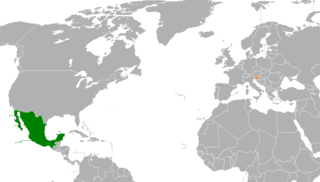
The nations of Mexico and Slovenia established diplomatic relations in 1992. Both nations are members of the Organisation for Economic Co-operation and Development and the United Nations.
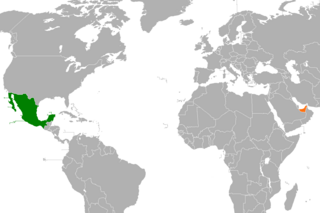
Mexico–United Arab Emirates relations are the diplomatic relations between Mexico and the United Arab Emirates. Both nations are members of the United Nations.
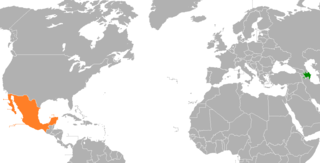
Azerbaijan–Mexico relations are the diplomatic relations between Azerbaijan and Mexico. Both nations are members of the United Nations.
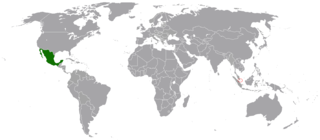
The United Mexican States and the Republic of Singapore have had diplomatic and other bilateral relations since 1975. Both nations are members of the Asia-Pacific Economic Cooperation and the United Nations.

Kazakhstan–Mexico relations are the bilateral relations between Kazakhstan and Mexico. Both nations are members of the United Nations and the World Trade Organization.

The Zurich Protocols refer to two bilateral protocols signed in 2009 by Armenia and Turkey that envisioned starting the process of normalizing relations between the two countries. The Protocols included provisions for the establishment of formal diplomatic relations, the opening of the Turkish-Armenian border, and the establishment of a joint historical commission on the Armenian genocide issue. The agreement, which later proved to be ineffectual, had been brokered by the United States, Russia and France.

Relations between Armenia and Brazil, have existed for decades. The Armenian community in Brazil is the second largest in Latin America totaling approximately 100,000 members.

Armenia–Spain relations are the bilateral relations between Armenia and Spain. The importance of relations centers on the history of Armenians migration to Spain. Approximately 40,000 Armenians and their descendants reside in Spain. Both nations are members of the Council of Europe.

Diplomatic relations exist between Azerbaijan and Uruguay. Neither country has a resident ambassador.
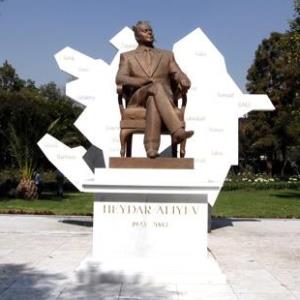
The statue of Heydar Aliyev is a bronze sculpture of the third president of Azerbaijan, Heydar Aliyev, previously installed along Paseo de la Reforma, in Chapultepec, Miguel Hidalgo, Mexico City.